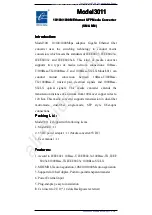
11
OPM-109
REV A
Note: Wire #93 is energized to turn on the glow plugs for 15 seconds
first and then the starter and fuel solenoid are engaged.
If the engine fails to start during this cranking period, the starter motor
is disengaged and goes into a rest mode after which a second attempt
is made to start the engine. Should this sequence continue through 3
cranking cycles the start sequence will be stopped and the display will
show ‘FAILED TO START”.
3. During manual operation, the load will not normally be applied to the
generator. But caution must be used, if the line power should fail or be
turned off the transfer switch during manual operation the load may be
applied to the generator.
With the engine running smoothly check the no load voltage and
frequency on the digital display. The voltage should be 208/240/480 AC
depending on which model you have and a frequency of 59.5 to 60.5
hertz (Hz).
If you have the proper voltage at the generator the next step is to
check the voltage at the generator terminals in the Automatic Transfer
Switch. The voltage between the G1 and the G3 terminals should be
the same as it was on the generator front panel. The voltage should
also be checked between the hot terminals (G1 and G3) and the G-N to
be certain of a balanced voltage output and a solid neutral connection.
The voltage between G1 and G-N should be about 120 volts AC (277
on 480 units). The same approximate voltage should be found between
terminals G3 and G-N (120 volts AC).
On three phase panels the G2 voltage level should also be checked.
ON 240 VOLT (DELTA) SYSTEMS BE SURE YOU KNOW WHERE
THE HIGH VOLTAGE “WILD” LEG IS. IT MUST BE IN THE SAME
LOCATION ON THE LINE SIDE AS IT IS ON THE GENERATOR SIDE.
(i.e. if it’s on L-3 on the line side it must be on G-3 on the generator
side.
Also on three phase systems make sure that the rotation
is the same on the generator as it is on your line power. Failure
to insure proper rotation will cause three phase motors to spin
backwards possibly damaging them.
NOTICE:
If for any reason during the check out procedure the voltage and
frequency are not correct, depress the STOP/RESET button and
correct the trouble before proceeding.
4. Stopping - There are two ways to stop the unit when it is in the
manual mode. Pressing the STOP/RESET button will stop the unit
immediately. Pressing the AUTO mode button will stop the unit but only
after the cool down timers have timed out and there is no remote start
signal being sent to the unit.
AUTO MODE
To activate the automatic start mode you will just need to depress the
AUTO button, the LED indicator beside the button confirms that the unit
is in automatic mode.
To test the Automatic Transfer Switch, follow the instruction on the
operator’s manual that came with the transfer switch. If you get a fault
during the initial start up or prior to start up, it is most likely a false
warning light. Simply reset the ATS start over.
Once you have completed testing of the ATS, be sure you ALWAYS
leave the system in the standby mode,unless servicing the unit. For
standby operation, press the AUTO button on the front of the control.
The green light should light up next to the AUTO button.
NOTE: For setting the exerciser circuit, for all ATS, see the operator’s
manual shipped with the ATS.
MAINTENANCE SCHEDULE
SERVICE
INTERVALS
Check Engine Oil Level
Daily
Check Coolant Level and for Leakage
Daily
Check Air Filter
Daily
Check Electrolyte Level in Battery and Clean Terminals
90 Days
Drain Water from Fuel Pre-Filter
Daily
Check Belts and Belt Tension
Daily
Check Preheating Operation
Daily
Change Oil - Initial
-
After
Initial
50 Hours
250 Hours
Change Oil Filters - Initial
-
After
Initial
50 Hours
500 Hours
Change Fuel Filters
500 Hours
Check Exhaust System for Damage
180 Days
Clean Fuel Tank
180 Days
Change Air Filter (depending on conditions)
600 Hours
Check Valve Clearance
1000 Hours
Clean Crankcase Ventilation Valve
1500 Hours
Change Coolant/Clean System
1000 Hours
* There are additional maintenance items and explanations in the
engine operator’s manual. Read thoroughly before operating this unit.


































